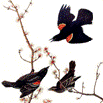Wildlife Damage Management, Internet Center for
Document Type
Article
Date of this Version
October 1973
Abstract
Determination of the importance and distribution of bird damage to agricultural crops in the United States has been emphasized by the Section of Birds at the Denver Wildlife Research Center in recent years. Our studies can be placed in two general categories: (1) For some crops we have conducted statistically designed quantitative field surveys to determine bird damage and have extrapolated from test plot data, and (2) for other crops we have directed questionnaires to persons knowledgeable about bird damage. Questionnaire surveys are obviously subjective and are biased to an unknown degree, but for some crops there is no reasonable alternative method of determining bird damage over regional or continental areas. Questionnaires at least serve to indicate the general level of damage and the relative seriousness of the problem to the grower. Such information is vital in setting research and management priorities and in determining the economics of damage control practices. The total bird damage picture includes the frequency distribution of losses as well as the average loss. Bird damage is usually unevenly distributed among growers and "average" damage rarely occurs. A crop that yields a good profit margin on the average may be a failure for those growers that suffer heavy losses to birds. The distribution of damage among growers is therefore considered a very important component of loss in the following summary. Details of design, analysis, and results of the studies I have summarized can be found in the original reports cited, all of which have been or will be published elsewhere.


